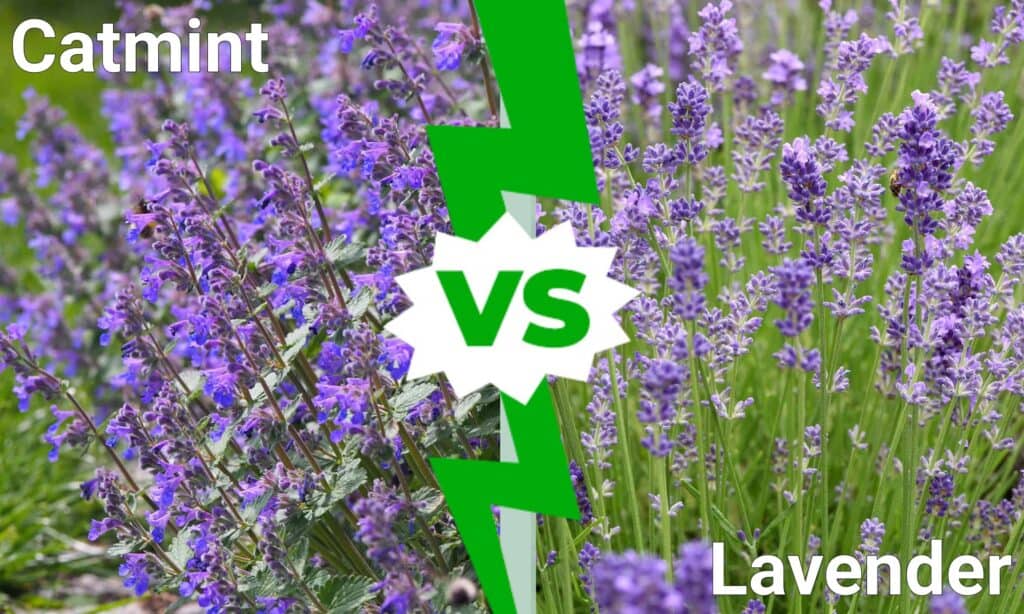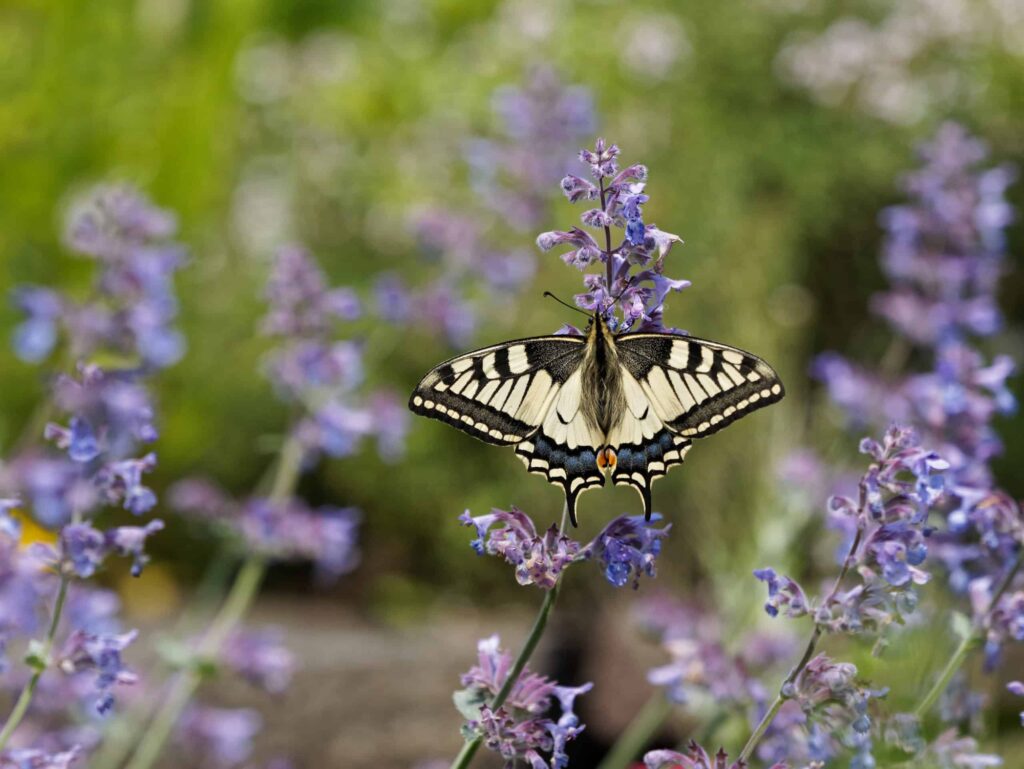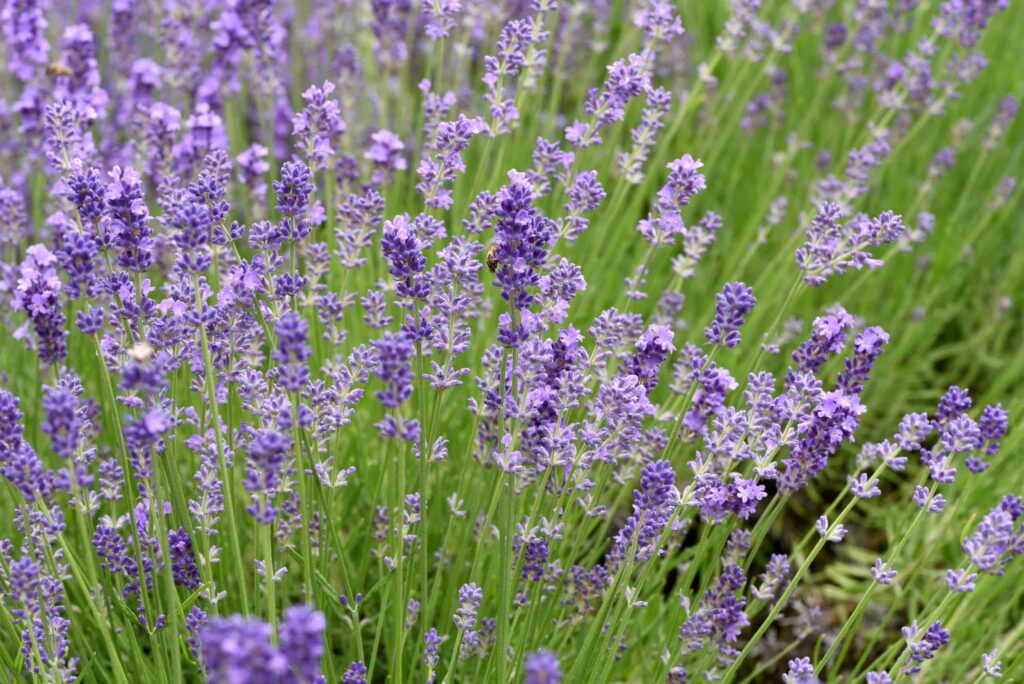While they have some undeniable similarities, there are a number of differences between catmint vs lavender. Both of these plants grow striking purple flowers depending on the time of year, but what are the main differences between these blooms, and how can you learn how to tell them apart?
In this article, we will compare and contrast catmint with lavender so that you can fully understand the differences between them. We will address what they look like physically as well as what they are typically used for in the average garden or home. Finally, we will address how they grow best in case you are interested in cultivating a plant of your own. Let’s get started!
Comparing Catmint vs Lavender

| Catmint | Lavender | |
|---|---|---|
| Plant Family and Genus | Lamiaceae; Nepeta | Lamiaceae; Lavandula |
| Description | Sweet smelling purple-blue blooms reach up to 2 feet tall and 3 feet wide. Leaves are rounded and grow opposite one another, with intricate veins similar to mint plants. The leaves smell nice as well, and the flowers have a unique double-lipped appearance | One of a kind smelling blooms in gray-violet shades reach up to 7 feet tall and just as wide, depending on the variety. Leaves are often narrow and long, but it depends on the variety. Flowers grow on narrow stems and form petals across from each other down the stem |
| Uses | Popular ground cover or a garden addition that attracts bees as well as cats. Can be eaten and used frequently in teas or medicinal remedies | Popular ornamental shrub in many gardens, as it attracts bees and other pollinators. Can be eaten or made into essential oils given its trademark scent |
| Origin and Growing Preferences | Native to Europe and Asia; enjoys full sun or partial shade and well-draining soil, offering some level of drought tolerance | Native to Africa and Europe; enjoys full sun to produce plenty of blooms and well-draining soil. Prefers less water as opposed to more |
| Special Features and Fun Facts | A member of the catnip species, cats are wildly attracted to this plant! | Commonly used for a number of medicinal purposes, including as a sleep and anxiety aid! |
Key Differences Between Catmint vs Lavender

When it comes to their sizes, most lavender plants grow taller and wider than the average catmint plants.
©Anna Gratys/Shutterstock.com
There are a number of key differences between catmint and lavender. For example, most lavender varieties grow larger compared to catmint plants. In addition, lavender has a more distinct scent compared to catmint. The leaves found on most catmint plants are larger than the leaves found on most lavender plants. Finally, catmint attracts cats, while lavender does not.
Let’s go over all of these differences in more detail now.
Catmint vs Lavender: Classification
While catmint and lavender look similar to each other, they both belong to different species. However, it is important to note that catmint and lavender belong to the mint family, also known as Lamiaceae. Unsurprisingly, catmint is a member of the catnip genus, also known as Nepeta, while lavender can be classified as Lavandula.
Catmint vs Lavender: Description

Most catmint leaves resemble mint leaves more often than not, while lavender leaves are typically narrower and longer by comparison.
©iStock.com/igoriss
There are some undeniable similarities between catmint and lavender. Both of these plants grow delicate purplish flowers, though catmint plants tend to be more blue compared to the gray found in lavender plants. In addition, catmint leaves resemble mint leaves more often than not, while lavender leaves are typically narrower and longer by comparison. However, it always depends on the specific varieties you are comparing!
When it comes to their sizes, most lavender plants grow taller and wider than the average catmint plants. In fact, catmint is often used as a ground cover, while lavender is typically used as a shrub. Finally, lavender plants often have a fuzzy texture, while catmint plants do not. The blooms on both of these plants grow similarly to one another, though many lavender varieties are more delicate compared to catmint.
Catmint vs Lavender: Uses

Catmint attracts the average house cat, while lavender does not do this.
©pipapur/Shutterstock.com
While it may surprise you to learn this, both lavender and catmint are used as medicinal remedies around the world. Lavender is fantastic for relieving stress and anxiety, while catmint is ideal for upset stomachs. Both of these plants are great in the average garden given that they attract a number of pollinators, but catmint also attracts the average house cat, while lavender does not do this.
Catmint vs Lavender: Origin and How to Grow
Catmint and lavender have similar origins as well as growing preferences, but there are some subtle differences between the two. For example, lavender is native to Africa and Europe, while catmint is native to Asia and Europe. In addition, both of these plants offer a certain level of drought tolerance, though catmint needs to be established before it is drought hardy, while lavender prefers drier soil overall. Plant both of these plants in full sun for an abundance of blooms!
Catmint vs Lavender: Special Features

Catmint needs to be established before it is drought hardy, while lavender prefers drier soil overall.
©Manfred Ruckszio/Shutterstock.com
No matter which one you prefer, both lavender and catmint smell delightful in any backyard garden. You may want to utilize catmint’s stomach soothing medicinal properties, or perhaps you want some catnip for your family cats! Lavender is also a great herb to have on hand for culinary and medicinal purposes, as it smells wonderful and can soothe an anxious mind!
The photo featured at the top of this post is © Anna Gratys/Shutterstock.com
Thank you for reading! Have some feedback for us? Contact the AZ Animals editorial team.






